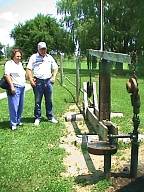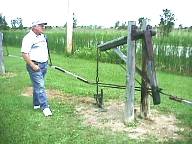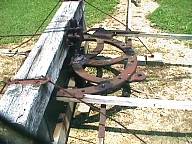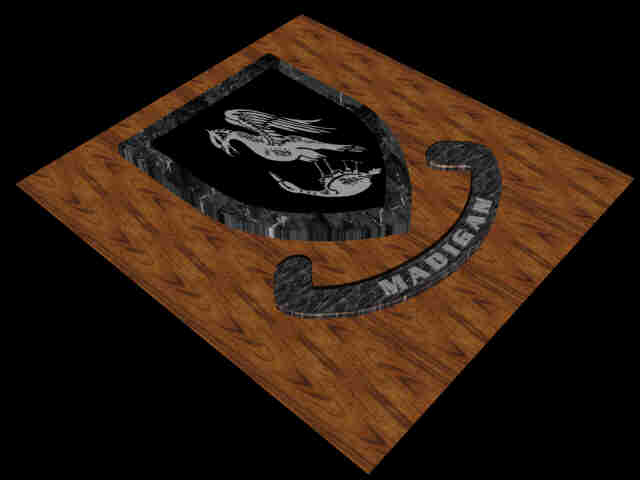One morning he woke to
tell his friends that he was a broken and beaten man, and that
this was his last day of drilling the old well. By afternoon he
had drilled just one more foot when there was a loud crack from
the bottom of his well that could be heard all over  the
entire field, and moments later heavy thick oil shot up to tree
top level, splintering his drilling rig and blackening the grass.
The world's first gusher blew in with a spectacular roar on
January 16 1862. For days the well gushed out of control spewing
2000 barrels a day over the area. No one had seen or imagined any
thing like it. And it continued to gush for days while Shaw and
all others in the area tried to figure out how to stop it.
Finally, Shaw successfully stuffed a flex stuffed leather bag
down the bore hole and extended the drill pipe twenty feet above
the well head which brought it under control. It was estimated
that a hundred thousand barrels of oil had spewed out onto the
ground and filled the nearby creek to a depth of 4 inches. The
new pressured wells that were drilled after that could produce
thousands of barrels a day and soon forced the price of crude
down. By the end of 1862 over a thousand wells were producing
some 12,000 barrels a day, which would be the high point for all
times for this first of the oil towns.
the
entire field, and moments later heavy thick oil shot up to tree
top level, splintering his drilling rig and blackening the grass.
The world's first gusher blew in with a spectacular roar on
January 16 1862. For days the well gushed out of control spewing
2000 barrels a day over the area. No one had seen or imagined any
thing like it. And it continued to gush for days while Shaw and
all others in the area tried to figure out how to stop it.
Finally, Shaw successfully stuffed a flex stuffed leather bag
down the bore hole and extended the drill pipe twenty feet above
the well head which brought it under control. It was estimated
that a hundred thousand barrels of oil had spewed out onto the
ground and filled the nearby creek to a depth of 4 inches. The
new pressured wells that were drilled after that could produce
thousands of barrels a day and soon forced the price of crude
down. By the end of 1862 over a thousand wells were producing
some 12,000 barrels a day, which would be the high point for all
times for this first of the oil towns.  One month later, the first of the wells started
pumping salt water instead of oil. Within weeks most of the other
big wells did the same. Oil would remain a major product for the
area but never again in the volume of that year. The oil workers
were a fickle breed, soon running off to find oil in other parts
of the land, specifically in Petrolia, where another well had
just come in. But the oil story in Oil Springs was not over. Into
the mix came J.H. Fairbanks who came to Oil Springs in 1860 and
held his property there after moving to the Petrolia fields. A
man with an inventive mind, he designed a system known today as
the "jerker" rod system. Returning to the old small
shallow wells, and using a simple but effective ball and washer
pump, he connected hundreds of pumps to a single steam engine
with a series of four arm spider wheels set horizontally, pulling
four long lines of connecting wooden rods reaching into the oil
field. Spider
One month later, the first of the wells started
pumping salt water instead of oil. Within weeks most of the other
big wells did the same. Oil would remain a major product for the
area but never again in the volume of that year. The oil workers
were a fickle breed, soon running off to find oil in other parts
of the land, specifically in Petrolia, where another well had
just come in. But the oil story in Oil Springs was not over. Into
the mix came J.H. Fairbanks who came to Oil Springs in 1860 and
held his property there after moving to the Petrolia fields. A
man with an inventive mind, he designed a system known today as
the "jerker" rod system. Returning to the old small
shallow wells, and using a simple but effective ball and washer
pump, he connected hundreds of pumps to a single steam engine
with a series of four arm spider wheels set horizontally, pulling
four long lines of connecting wooden rods reaching into the oil
field. Spider wheels in the field were powered by relay
wheels near the plant and supplied push-pull power to a dozen or
more wells connected to each string of jerker rods. The new
pumping system kept the tired wells at Oil Springs pumping on an
economical basis but there was no call for further exploration.
Many of these jerker pumped wells still produce oil today in that
time-tested method. Some 26,000 barrels of oil a year are
produced from the wells today. It is estimated that over 10
million barrels of oil have been removed representing about 35
percent of the oil still available. Slowly the some 20 million
barrels still under ground seeps back into the original well
holes drilled some 75 years ago, producing about a barrel a week.
At its present speed of extraction, jerker rod pumps may be
pumping oil out of the ground well into the next century. A final
note on the museum itself.
wheels in the field were powered by relay
wheels near the plant and supplied push-pull power to a dozen or
more wells connected to each string of jerker rods. The new
pumping system kept the tired wells at Oil Springs pumping on an
economical basis but there was no call for further exploration.
Many of these jerker pumped wells still produce oil today in that
time-tested method. Some 26,000 barrels of oil a year are
produced from the wells today. It is estimated that over 10
million barrels of oil have been removed representing about 35
percent of the oil still available. Slowly the some 20 million
barrels still under ground seeps back into the original well
holes drilled some 75 years ago, producing about a barrel a week.
At its present speed of extraction, jerker rod pumps may be
pumping oil out of the ground well into the next century. A final
note on the museum itself.  The second floor of the building holds a
fascinating collection of artifacts collected by oilers from
Ontario who traveled around the world drilling for the precious
black gold. They brought back all kinds of strange critters which
have found their way from attics and basements into the halls of
the museum. From giant grasshoppers to fancy native spears, old
photographs from distant lands lay among the items. There seems
to be no particular rhyme or reason to the order but much of is
was quite interesting.
The second floor of the building holds a
fascinating collection of artifacts collected by oilers from
Ontario who traveled around the world drilling for the precious
black gold. They brought back all kinds of strange critters which
have found their way from attics and basements into the halls of
the museum. From giant grasshoppers to fancy native spears, old
photographs from distant lands lay among the items. There seems
to be no particular rhyme or reason to the order but much of is
was quite interesting.
*** THE END ***

 <<<<< Back
Next >>>>>
<<<<< Back
Next >>>>> 
 the
entire field, and moments later heavy thick oil shot up to tree
top level, splintering his drilling rig and blackening the grass.
The world's first gusher blew in with a spectacular roar on
January 16 1862. For days the well gushed out of control spewing
2000 barrels a day over the area. No one had seen or imagined any
thing like it. And it continued to gush for days while Shaw and
all others in the area tried to figure out how to stop it.
Finally, Shaw successfully stuffed a flex stuffed leather bag
down the bore hole and extended the drill pipe twenty feet above
the well head which brought it under control. It was estimated
that a hundred thousand barrels of oil had spewed out onto the
ground and filled the nearby creek to a depth of 4 inches. The
new pressured wells that were drilled after that could produce
thousands of barrels a day and soon forced the price of crude
down. By the end of 1862 over a thousand wells were producing
some 12,000 barrels a day, which would be the high point for all
times for this first of the oil towns.
the
entire field, and moments later heavy thick oil shot up to tree
top level, splintering his drilling rig and blackening the grass.
The world's first gusher blew in with a spectacular roar on
January 16 1862. For days the well gushed out of control spewing
2000 barrels a day over the area. No one had seen or imagined any
thing like it. And it continued to gush for days while Shaw and
all others in the area tried to figure out how to stop it.
Finally, Shaw successfully stuffed a flex stuffed leather bag
down the bore hole and extended the drill pipe twenty feet above
the well head which brought it under control. It was estimated
that a hundred thousand barrels of oil had spewed out onto the
ground and filled the nearby creek to a depth of 4 inches. The
new pressured wells that were drilled after that could produce
thousands of barrels a day and soon forced the price of crude
down. By the end of 1862 over a thousand wells were producing
some 12,000 barrels a day, which would be the high point for all
times for this first of the oil towns.  One month later, the first of the wells started
pumping salt water instead of oil. Within weeks most of the other
big wells did the same. Oil would remain a major product for the
area but never again in the volume of that year. The oil workers
were a fickle breed, soon running off to find oil in other parts
of the land, specifically in Petrolia, where another well had
just come in. But the oil story in Oil Springs was not over. Into
the mix came J.H. Fairbanks who came to Oil Springs in 1860 and
held his property there after moving to the Petrolia fields. A
man with an inventive mind, he designed a system known today as
the "jerker" rod system. Returning to the old small
shallow wells, and using a simple but effective ball and washer
pump, he connected hundreds of pumps to a single steam engine
with a series of four arm spider wheels set horizontally, pulling
four long lines of connecting wooden rods reaching into the oil
field. Spider
One month later, the first of the wells started
pumping salt water instead of oil. Within weeks most of the other
big wells did the same. Oil would remain a major product for the
area but never again in the volume of that year. The oil workers
were a fickle breed, soon running off to find oil in other parts
of the land, specifically in Petrolia, where another well had
just come in. But the oil story in Oil Springs was not over. Into
the mix came J.H. Fairbanks who came to Oil Springs in 1860 and
held his property there after moving to the Petrolia fields. A
man with an inventive mind, he designed a system known today as
the "jerker" rod system. Returning to the old small
shallow wells, and using a simple but effective ball and washer
pump, he connected hundreds of pumps to a single steam engine
with a series of four arm spider wheels set horizontally, pulling
four long lines of connecting wooden rods reaching into the oil
field. Spider wheels in the field were powered by relay
wheels near the plant and supplied push-pull power to a dozen or
more wells connected to each string of jerker rods. The new
pumping system kept the tired wells at Oil Springs pumping on an
economical basis but there was no call for further exploration.
Many of these jerker pumped wells still produce oil today in that
time-tested method. Some 26,000 barrels of oil a year are
produced from the wells today. It is estimated that over 10
million barrels of oil have been removed representing about 35
percent of the oil still available. Slowly the some 20 million
barrels still under ground seeps back into the original well
holes drilled some 75 years ago, producing about a barrel a week.
At its present speed of extraction, jerker rod pumps may be
pumping oil out of the ground well into the next century. A final
note on the museum itself.
wheels in the field were powered by relay
wheels near the plant and supplied push-pull power to a dozen or
more wells connected to each string of jerker rods. The new
pumping system kept the tired wells at Oil Springs pumping on an
economical basis but there was no call for further exploration.
Many of these jerker pumped wells still produce oil today in that
time-tested method. Some 26,000 barrels of oil a year are
produced from the wells today. It is estimated that over 10
million barrels of oil have been removed representing about 35
percent of the oil still available. Slowly the some 20 million
barrels still under ground seeps back into the original well
holes drilled some 75 years ago, producing about a barrel a week.
At its present speed of extraction, jerker rod pumps may be
pumping oil out of the ground well into the next century. A final
note on the museum itself.  The second floor of the building holds a
fascinating collection of artifacts collected by oilers from
Ontario who traveled around the world drilling for the precious
black gold. They brought back all kinds of strange critters which
have found their way from attics and basements into the halls of
the museum. From giant grasshoppers to fancy native spears, old
photographs from distant lands lay among the items. There seems
to be no particular rhyme or reason to the order but much of is
was quite interesting.
The second floor of the building holds a
fascinating collection of artifacts collected by oilers from
Ontario who traveled around the world drilling for the precious
black gold. They brought back all kinds of strange critters which
have found their way from attics and basements into the halls of
the museum. From giant grasshoppers to fancy native spears, old
photographs from distant lands lay among the items. There seems
to be no particular rhyme or reason to the order but much of is
was quite interesting.
